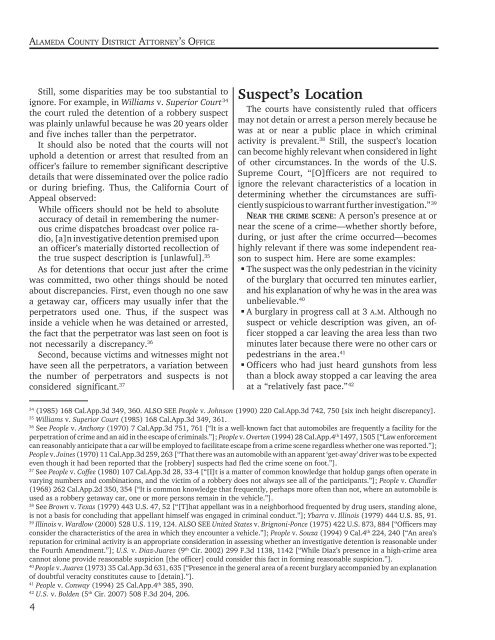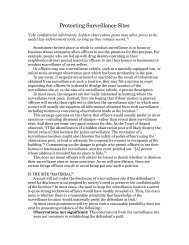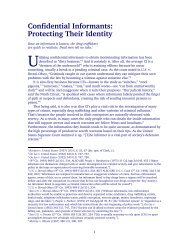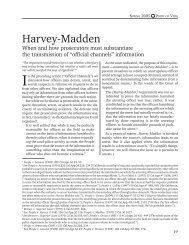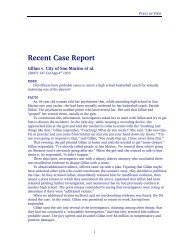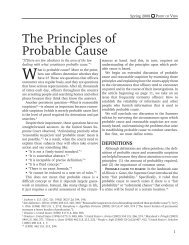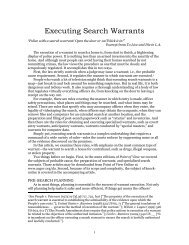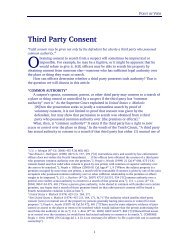PC TO ARREST.pmd - Alameda County District Attorney's Office
PC TO ARREST.pmd - Alameda County District Attorney's Office
PC TO ARREST.pmd - Alameda County District Attorney's Office
Create successful ePaper yourself
Turn your PDF publications into a flip-book with our unique Google optimized e-Paper software.
ALAMEDA COUNTY DISTRICT AT<strong>TO</strong>RNEY’S OFFICE<br />
Still, some disparities may be too substantial to<br />
ignore. For example, in Williams v. Superior Court 34<br />
the court ruled the detention of a robbery suspect<br />
was plainly unlawful because he was 20 years older<br />
and five inches taller than the perpetrator.<br />
It should also be noted that the courts will not<br />
uphold a detention or arrest that resulted from an<br />
officer’s failure to remember significant descriptive<br />
details that were disseminated over the police radio<br />
or during briefing. Thus, the California Court of<br />
Appeal observed:<br />
While officers should not be held to absolute<br />
accuracy of detail in remembering the numerous<br />
crime dispatches broadcast over police radio,<br />
[a]n investigative detention premised upon<br />
an officer’s materially distorted recollection of<br />
the true suspect description is [unlawful]. 35<br />
As for detentions that occur just after the crime<br />
was committed, two other things should be noted<br />
about discrepancies. First, even though no one saw<br />
a getaway car, officers may usually infer that the<br />
perpetrators used one. Thus, if the suspect was<br />
inside a vehicle when he was detained or arrested,<br />
the fact that the perpetrator was last seen on foot is<br />
not necessarily a discrepancy. 36<br />
Second, because victims and witnesses might not<br />
have seen all the perpetrators, a variation between<br />
the number of perpetrators and suspects is not<br />
considered significant. 37<br />
4<br />
Suspect’s Location<br />
The courts have consistently ruled that officers<br />
may not detain or arrest a person merely because he<br />
was at or near a public place in which criminal<br />
activity is prevalent. 38 Still, the suspect’s location<br />
can become highly relevant when considered in light<br />
of other circumstances. In the words of the U.S.<br />
Supreme Court, “[O]fficers are not required to<br />
ignore the relevant characteristics of a location in<br />
determining whether the circumstances are sufficiently<br />
suspicious to warrant further investigation.” 39<br />
NEAR THE CRIME SCENE: A person’s presence at or<br />
near the scene of a crime—whether shortly before,<br />
during, or just after the crime occurred—becomes<br />
highly relevant if there was some independent reason<br />
to suspect him. Here are some examples:<br />
� The suspect was the only pedestrian in the vicinity<br />
of the burglary that occurred ten minutes earlier,<br />
and his explanation of why he was in the area was<br />
unbelievable. 40<br />
� A burglary in progress call at 3 A.M. Although no<br />
suspect or vehicle description was given, an officer<br />
stopped a car leaving the area less than two<br />
minutes later because there were no other cars or<br />
pedestrians in the area. 41<br />
� <strong>Office</strong>rs who had just heard gunshots from less<br />
than a block away stopped a car leaving the area<br />
at a “relatively fast pace.” 42<br />
34 (1985) 168 Cal.App.3d 349, 360. ALSO SEE People v. Johnson (1990) 220 Cal.App.3d 742, 750 [six inch height discrepancy].<br />
35 Williams v. Superior Court (1985) 168 Cal.App.3d 349, 361.<br />
36 See People v. Anthony (1970) 7 Cal.App.3d 751, 761 [“It is a well-known fact that automobiles are frequently a facility for the<br />
perpetration of crime and an aid in the escape of criminals.”]; People v. Overten (1994) 28 Cal.App.4 th 1497, 1505 [“Law enforcement<br />
can reasonably anticipate that a car will be employed to facilitate escape from a crime scene regardless whether one was reported.”];<br />
People v. Joines (1970) 11 Cal.App.3d 259, 263 [“That there was an automobile with an apparent ‘get-away’ driver was to be expected<br />
even though it had been reported that the [robbery] suspects had fled the crime scene on foot.”].<br />
37 See People v. Coffee (1980) 107 Cal.App.3d 28, 33-4 [“[I]t is a matter of common knowledge that holdup gangs often operate in<br />
varying numbers and combinations, and the victim of a robbery does not always see all of the participants.”]; People v. Chandler<br />
(1968) 262 Cal.App.2d 350, 354 [“It is common knowledge that frequently, perhaps more often than not, where an automobile is<br />
used as a robbery getaway car, one or more persons remain in the vehicle.”].<br />
38 See Brown v. Texas (1979) 443 U.S. 47, 52 [“[T]hat appellant was in a neighborhood frequented by drug users, standing alone,<br />
is not a basis for concluding that appellant himself was engaged in criminal conduct.”]; Ybarra v. Illinois (1979) 444 U.S. 85, 91.<br />
39 Illinois v. Wardlow (2000) 528 U.S. 119, 124. ALSO SEE United States v. Brignoni-Ponce (1975) 422 U.S. 873, 884 [“<strong>Office</strong>rs may<br />
consider the characteristics of the area in which they encounter a vehicle.”]; People v. Souza (1994) 9 Cal.4 th 224, 240 [“An area’s<br />
reputation for criminal activity is an appropriate consideration in assessing whether an investigative detention is reasonable under<br />
the Fourth Amendment.”]; U.S. v. Diaz-Juarez (9 th Cir. 2002) 299 F.3d 1138, 1142 [“While Diaz’s presence in a high-crime area<br />
cannot alone provide reasonable suspicion [the officer] could consider this fact in forming reasonable suspicion.”].<br />
40 People v. Juarez (1973) 35 Cal.App.3d 631, 635 [“Presence in the general area of a recent burglary accompanied by an explanation<br />
of doubtful veracity constitutes cause to [detain].”].<br />
41 People v. Conway (1994) 25 Cal.App.4 th 385, 390.<br />
42 U.S. v. Bolden (5 th Cir. 2007) 508 F.3d 204, 206.


